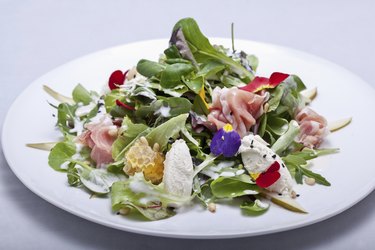
Salads don't have to be boring iceberg lettuce and tomato quarters -- the ingredients are limited only to your imagination. Salad bases can include a range of greens, from sweet young spinach to spicy and peppery arugula. Keep in mind the flavor of your base greens as you select seasonings -- pair sweeter toppings with more bitter greens to round out the taste of your salad.
Basic Bases
Video of the Day
Classic seasonings for salads include vinegars, such as apple cider, red wine vinegar and balsamic, and different oils. Vinegar adds a sour tang to salads that livens up more earthy base greens, such as spinach. Balsamic vinegar bears up with a little more sweetness than other vinegars, and mixes well with a variety of oils. Oils for salad seasoning range from the dependable extra-virgin olive oil to nut oils such as hazelnut, walnut and avocado. Sesame oil adds a distinctive Asian taste, especially when paired with rice wine vinegar.
Video of the Day
Getting Fruity
Fruits lend just the right touch of sweetness to more bitter greens such as arugula. Dried fruits add texture and provide a blend of starting notes: dried cranberries give your salad a vibrant zing, dried strawberries boost color and sweetness and dried apricots pair well with any salad that includes cheese. Fresh fruits, such as citrus or pomegranate seeds, liven up salads, especially in winter.
Herbal Tastes
When choosing herbs to season your salad, whether fresh or dried, use only one dominant herb to avoid overpowering the salad as a whole. Strongly flavored herbs include thyme, rosemary, sage, mint and dill. Complement the bold flavors of these herbs with milder ones such as parsley, chives and chervil. Preserve fresh herbs by freezing them, then chop and add to your salad.
Beef It Up
For a heartier feel to a salad, use meats and fishes to bring flavor. Anchovy paste blended with a little olive oil is a distinctive salad seasoning, but be aware of the inherent saltiness of these tiny fish. Crumbled bacon, chopped ham, chicken or crumbled ground beef can turn a side salad into a filling main dish.
Floral Notes
Edible flowers lend a touch of beauty and class to salads and bring delicate flavors. Marigolds are peppery with a mild spice, and lavender is heavily floral and a little lemony. Young dandelions are sweet, but can become bitter the older they are. Hibiscus flowers can be served fresh or dried, and are a vibrantly colorful blossom that tastes of cranberries.
Nutty Flavors
Seasonings that add texture are an important element to salad crafting. Sunflower seeds need little additional salt, but should be shelled. Sesame seeds can be added toasted or raw and pair well with sweet dressings. Walnuts, almonds and hazelnuts bring distinctive flavor profiles to salads, as well as adding crunch. Grains, such as toasted amaranth, rye or cooked quinoa build a salad's base notes and take on the flavors of your dressings and other seasonings.